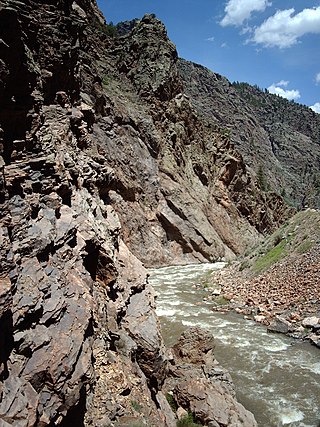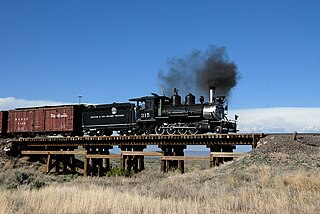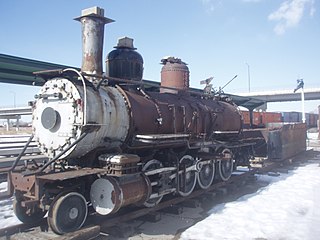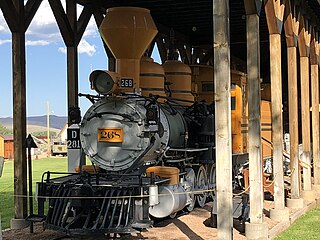
The Denver and Rio Grande Western Railroad, often shortened to Rio Grande, D&RG or D&RGW, formerly the Denver & Rio Grande Railroad, was an American Class I railroad company. The railroad started as a 3 ft narrow-gauge line running south from Denver, Colorado, in 1870. It served mainly as a transcontinental bridge line between Denver and Ogden, Utah. The Rio Grande was also a major origin of coal and mineral traffic.

Curecanti National Recreation Area is a National Park Service unit located on the Gunnison River in western Colorado. Established in 1965, Curecanti National Recreation Area is responsible for developing and managing recreational facilities on three reservoirs, Blue Mesa Reservoir, Morrow Point Reservoir and Crystal Reservoir, constructed on the upper Gunnison River in the 1960s by the U.S. Bureau of Reclamation to better utilize the vital waters of the Colorado River and its major tributaries. A popular destination for boating and fishing, Curecanti offers visitors two marinas, traditional and group campgrounds, hiking trails, boat launches, and boat-in campsites. The state's premiere lake trout and Kokanee salmon fisheries, Curecanti is a popular destination for boating and fishing, and is also a popular area for ice-fishing in the winter months.

The Cumbres and Toltec Scenic Railroad, often abbreviated as the C&TSRR, is a 3 ft narrow-gauge heritage railroad that operates on 64 miles (103 km) of track between Antonito, Colorado, and Chama, New Mexico, in the United States. The railroad is named for two geographical features along the route: the 10,015-foot (3,053 m)-high Cumbres Pass and the Toltec Gorge. Originally part of the Denver and Rio Grande Western Railroad's narrow-gauge network, the line has been jointly owned by the states of Colorado and New Mexico since 1970.

Cimarron is an unincorporated rural hamlet in Montrose County, Colorado, United States. It is located on the northern side of U.S. Highway 50, 19 miles from the town of Montrose to its west, and 42 miles from Gunnison, Colorado to its east. There is a store with fuel pumps and a post office at Cimarron. The post office services the rural ZIP Code 81220 area.

The Durango and Silverton Narrow Gauge Railroad, often abbreviated as the D&SNG, is a 3 ft (914 mm) narrow-gauge heritage railroad that operates on 45.2 miles (72.7 km) of track between Durango and Silverton, in the U.S. state of Colorado. The railway is a federally-designated National Historic Landmark and was also designated by the American Society of Civil Engineers as a National Historic Civil Engineering Landmark in 1968.

The Ghost Town & Calico Railway is a 3 ft narrow-gauge heritage railroad and amusement park attraction within Knott's Berry Farm, an amusement park located in Buena Park, California.

The Rio Grande Southern Railroad was a 3 ft (914 mm) narrow-gauge railroad which ran in the southwestern region of the US state of Colorado, from the towns of Durango to Ridgway, routed via Lizard Head Pass. Built by German immigrant and Colorado toll road builder Otto Mears, the RGS operated from 1891 through 1951 and was built with the intent to transport immense amounts of silver mineral traffic that were being produced by the mining communities of Rico and Telluride. On both ends of the railroad, there were interchanges with The Denver and Rio Grande Railroad, which would ship the traffic the RGS hauled elsewhere like the San Juan Smelter in Durango.

The Cimarron River is a 22.0-mile-long (35.4 km) tributary that joins the Gunnison River in Curecanti National Recreation Area near Cimarron, Colorado. The river's source is the confluence of two forks near Silver Jack Reservoir in the Uncompahgre National Forest.

The Denver and Rio Grande Western K-27 is a class of 3 ft narrow gauge 2-8-2 "Mikado" type steam locomotives built for the Denver and Rio Grande Railroad by the Baldwin Locomotive Works in 1903. Known by their nickname "Mudhens," they were the first and the most numerous of the four K classes of Rio Grande narrow gauge engines to be built. Two of the original fleet of 15 locomotives were preserved and operate on heritage railways in the United States. No. 463 is operational on the Cumbres and Toltec Scenic Railroad (C&TSRR) in Chama, New Mexico and No. 464 is currently out of service due to a rebuild on the Huckleberry Railroad in Genesee Township, Michigan.

The Utah Division of the former Denver & Rio Grande Western Railroad (D&RGW) is a rail line that connects Grand Junction, Colorado and Salt Lake City, Utah in the Western United States. It is now incorporated into the Union Pacific Railroad (UP) system as part of the Central Corridor. The modern Union Pacific has split the line into two subdivisions for operational purposes, the Green River Subdivision between Grand Junction and Helper, Utah and the Provo Subdivision from Helper to Salt Lake City. Daily passenger service is provided by Amtrak's California Zephyr; the BNSF Railway and Utah Railway have trackage rights over the line.

The Denver and Rio Grande Western K-37 is a class of 2-8-2 "Mikado" type narrow-gauge steam locomotives built for the Denver and Rio Grande Western Railroad. They were new steam locomotives built in the D&RGW Burnham Shops as a near copy of the Rio Grande class K-36. In-house production was chosen to preemptively address material shortages and personnel issues. Burnham Shops was assisted in the construction of the class by the Stearn-Rogers Manufacturing Company. The class recycled components from Baldwin Locomotive Works-built Class 19 2-8-0 locomotives used on the Rio Grande's standard gauge; re-using the boiler, tender and other components salvaged from the C-41's. The engine components were constructed new for the locomotive class.

The Curecanti Needle is a 700-ft granite spire located on the Gunnison River in western Colorado. A notable landmark to generations of natives and pioneers, the Needle is located on the southern bank of Morrow Point Reservoir, an impoundment of the Gunnison river between Gunnison and Montrose, Colorado. Used for many years as an advertising symbol for the Denver and Rio Grande Western Railroad, whose narrow-gauge railway famously ran along the northern bank of the river and passed near the Needle, the spire is today part of the Curecanti National Recreation Area, a National Park Service facility that encompasses three impoundments of the Gunnison river, including Morrow Point Reservoir.

Denver and Rio Grande Western No. 315 is a class "C-18" 2-8-0 "Consolidation" type narrow-gauge steam locomotive that was originally built for the Florence and Cripple Creek Railroad by the Baldwin Locomotive Works in 1895. It was purchased by the Denver and Rio Grande Railroad (D&RG) in 1917 and later became known as No. 315. It was retired in 1949 and had been on display at City of Durango parks until the Durango Railroad Historical Society restored the locomotive from 2001 to August 2007. It was operational from then until September 2021. On March 8, 2023, it returned to service, following its FRA federally mandated 1,472-day boiler inspection and overhaul. Most "sister" locomotives to No. 315 were scrapped, but two others survive today: D&RGW No. 318, on display at the Colorado Railroad Museum; and F&CC No. 10, currently in storage at the Nevada Southern Railroad Museum.

Denver and Rio Grande Western No. 169 is a 4-6-0 "Ten Wheeler" type narrow gauge steam locomotive. It is one of twelve similar locomotives built for the Denver and Rio Grande Railroad (D&RGW) by Baldwin Locomotive Works in 1883. It was built as a passenger locomotive, with 46 in (1,200 mm) drivers, the second largest drivers used on any three-foot gauge D&RGW locomotive.

Denver and Rio Grande Western No. 168 is a class "T-12" 4-6-0 “Ten Wheeler” type narrow-gauge steam locomotive. It is one of twelve similar locomotives built for the Denver and Rio Grande Railroad (D&RG) by the Baldwin Locomotive Works in 1883. It was built as a passenger locomotive, with 46 in (1,200 mm) drivers, the largest drivers used on any three-foot gauge D&RGW locomotive. The large drivers made it suitable for relatively fast passenger service.

Denver and Rio Grande Western 223 is a 2-8-0 "Consolidation" type narrow-gauge steam locomotive built for the Denver and Rio Grande Railroad by the Grant Locomotive Works of Paterson, New Jersey in 1881–82. Number 223 was completed in December 1881, at a cost of $11,553. Rio Grande 223 is the only surviving narrow-gauge engine built by Grant Locomotive Works. D&RGW 223 and the other Class 60 engines were part of the Rio Grande's expansion into Colorado and Utah in the 1880s.

Cumbres and Toltec Scenic Railroad 463 is a 3-foot narrow-gauge class "K-27" 2-8-2 "Mikado" type steam locomotive built for the Denver and Rio Grande Railroad (D&RG) by the Baldwin Locomotive Works in 1903. It is one of two remaining Rio Grande K-27 locomotives, the other one being No. 464 at the Huckleberry Railroad in Genesee Township, Michigan. The class eventually became known by the nickname "Mudhens". Today, No. 463 is operational on the Cumbres and Toltec Scenic Railroad between Chama, New Mexico and Antonito, Colorado.

Morrow Point Reservoir is an 817-acre (331 ha) artificial reservoir on the Gunnison River in western Colorado. Located in the upper Black Canyon of the Gunnison, the lake was created in 1968 by the U.S. Bureau of Reclamation as part of a larger plan to impound the upper section of the Gunnison and create opportunities for hydroelectric power generation, water conservation, and recreation. Morrow Point Reservoir is managed by the National Park Service as a unit within the Curecanti National Recreation Area, and is the location of the Curecanti Needle, a striking 700-foot (210 m) granite spire on the reservoir's southern bank whose unique shape was for decades a recognized symbol of the Denver and Rio Grande Western Railroad.

Cerro Summit is a mountain pass in the State of Colorado, located about 14 miles east of Montrose, Colorado. It divides the watershed of the Cimmaron River to the east and the Uncompahgre River to the west, both of which eventually flow into the Gunnison River.

Rio Grande 268 is a 2-8-0 "Consolidation" type narrow-gauge steam locomotive built for the Denver and Rio Grande Western Railroad by the Baldwin Locomotive Works in 1882. It is one of three surviving locomotives in D&RG class 60.





























